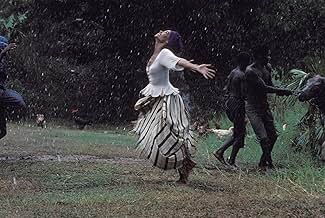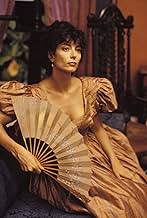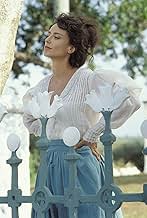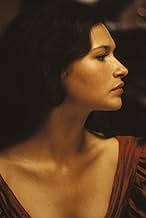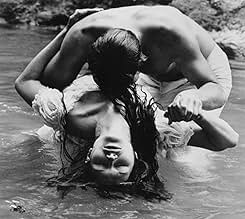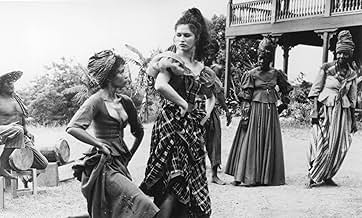IMDb RATING
5.6/10
2.3K
YOUR RATING
In 1840s Jamaica, a young female landowner marries an Englishman to keep her property. Their love blossoms, but she hides a childhood secret about her mother that threatens their relationshi... Read allIn 1840s Jamaica, a young female landowner marries an Englishman to keep her property. Their love blossoms, but she hides a childhood secret about her mother that threatens their relationship.In 1840s Jamaica, a young female landowner marries an Englishman to keep her property. Their love blossoms, but she hides a childhood secret about her mother that threatens their relationship.
Martine Beswick
- Aunt Cora
- (as Martine Beswicke)
Storyline
Did you know
- TriviaThe picture was classified and rated with a restricted NC-17 rating in the USA due to its explicit sexual content. Distributor Fine Line Features decided not to appeal the decision in order to try and gain a lower classification rating to make the movie marketable and able for younger audiences to attend. The New York Times reported "Fine Line Features, the art-film division of New Line Cinema, has accepted the rating for 'Wide Sargasso Sea (1993)' which includes male frontal nudity".
- Quotes
Edward Rochester: England seems far away.
- Alternate versionsEdited, R-rated version available on video.
Featured review
I think that there seem to be some confusion expressed in a number of the reviews of this and a subsequent version of Jean Rhys' most famous novel. Just for information:
1. Creole does not necessarily imply mixed race. Bertha (to use Rochester's name for her) was clearly white enough to appear white and indeed, like Jean Rhys herself, may have been entirely of European ancestry. The mixed race brother, Daniel, was black on his mother's side which has nothing to do with Bertha's mother being mostly/entirely French. He was angry and destructive because his father preferred the white daughter to him.
2. The Wide Sargosso Sea is a sort of prequel but it is also a re-imagining of the back story for Jane Eyre that is intended to take Bertha's character and expand on it with Rhys inability to ever fully reconcile herself to the differences between her origins and life in Europe.
3. While we think of the Caribbean as a dominantly black environment, the origins were Carib Indian and whites colonized the area before the introduction of African slaves. The racial undertone is a more modern view than Bronte likely had. She was trying to deal with the whole idea of foreignness/strangeness and the ultimate solution to the plight of Jane's situation, poor but of "gentle" birth.
4. Of the two filmed versions, the first makes the characters too physically attractive and really misses the novel's stress on the protagonists never meshing rather than loving and losing love.
5. One problem with the casting of Rochester in the first version is that the actor portraying Rochester is distractingly gorgeous and not sufficiently British (apart from his accent). In fact he looks like he rather fits in, in contrast to Bertha's uncle and the other European planters. Of course, the actress who portrays Bertha, even at the end, is so enticing that Rochester's loss of interest is inexplicable.
6. The first film seems to run out of time and rushes the end. Not enough is made of Rochester's anger at being manipulated, whether by voodoo, drugs or circumstances. Once he becomes his father's heir, the return to England should have led to something other than the conclusion. There is definitely insufficient deterioration in Bertha. Their stories are mirror images. He deteriorates and is miserable where she is able to live and she deteriorates where he is able to live.
7. The novels (both Jane Eyre and The Wide Sargosso Sea) have a great deal of narration which is lost in the earlier film and perhaps insufficient in the second. None of the films are substitutes for the books but all are interesting reimaginings.
8. In order to appreciate the Rhys novel, one should read about the author. The same is true of Jane Eyre and its author. The more things change, the more they stay the same.
Finally, while not great, the films both aspire to be literary, which means a lot in an age when filmmakers think there is a need for horror/splatter movies and lots of people apparently agree so I for one say thank you for both versions of the Wide Sargosso Sea and all of the versions of Jane Eyre that offer relief from the current tripe.
1. Creole does not necessarily imply mixed race. Bertha (to use Rochester's name for her) was clearly white enough to appear white and indeed, like Jean Rhys herself, may have been entirely of European ancestry. The mixed race brother, Daniel, was black on his mother's side which has nothing to do with Bertha's mother being mostly/entirely French. He was angry and destructive because his father preferred the white daughter to him.
2. The Wide Sargosso Sea is a sort of prequel but it is also a re-imagining of the back story for Jane Eyre that is intended to take Bertha's character and expand on it with Rhys inability to ever fully reconcile herself to the differences between her origins and life in Europe.
3. While we think of the Caribbean as a dominantly black environment, the origins were Carib Indian and whites colonized the area before the introduction of African slaves. The racial undertone is a more modern view than Bronte likely had. She was trying to deal with the whole idea of foreignness/strangeness and the ultimate solution to the plight of Jane's situation, poor but of "gentle" birth.
4. Of the two filmed versions, the first makes the characters too physically attractive and really misses the novel's stress on the protagonists never meshing rather than loving and losing love.
5. One problem with the casting of Rochester in the first version is that the actor portraying Rochester is distractingly gorgeous and not sufficiently British (apart from his accent). In fact he looks like he rather fits in, in contrast to Bertha's uncle and the other European planters. Of course, the actress who portrays Bertha, even at the end, is so enticing that Rochester's loss of interest is inexplicable.
6. The first film seems to run out of time and rushes the end. Not enough is made of Rochester's anger at being manipulated, whether by voodoo, drugs or circumstances. Once he becomes his father's heir, the return to England should have led to something other than the conclusion. There is definitely insufficient deterioration in Bertha. Their stories are mirror images. He deteriorates and is miserable where she is able to live and she deteriorates where he is able to live.
7. The novels (both Jane Eyre and The Wide Sargosso Sea) have a great deal of narration which is lost in the earlier film and perhaps insufficient in the second. None of the films are substitutes for the books but all are interesting reimaginings.
8. In order to appreciate the Rhys novel, one should read about the author. The same is true of Jane Eyre and its author. The more things change, the more they stay the same.
Finally, while not great, the films both aspire to be literary, which means a lot in an age when filmmakers think there is a need for horror/splatter movies and lots of people apparently agree so I for one say thank you for both versions of the Wide Sargosso Sea and all of the versions of Jane Eyre that offer relief from the current tripe.
- How long is Wide Sargasso Sea?Powered by Alexa
Details
Box office
- Budget
- $4,500,000 (estimated)
- Gross US & Canada
- $1,614,784
- Opening weekend US & Canada
- $33,806
- Apr 18, 1993
- Gross worldwide
- $1,614,784
- Runtime1 hour 39 minutes
- Color
- Aspect ratio
- 1.85 : 1
Contribute to this page
Suggest an edit or add missing content



